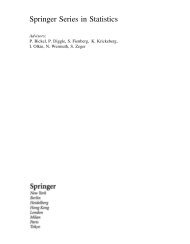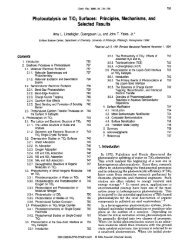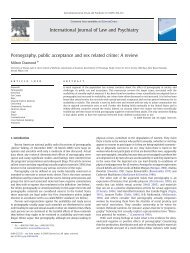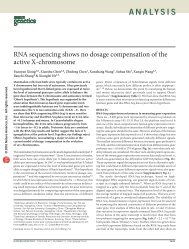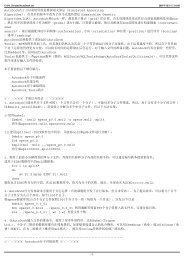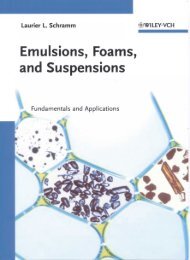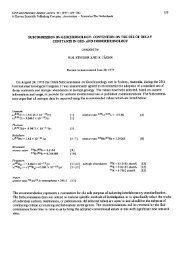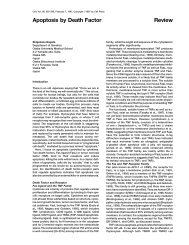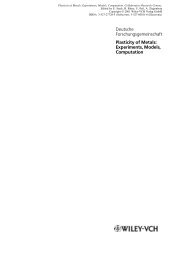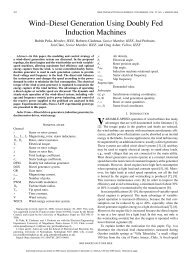Culture and Maintenance of Agrobacterium Strains
Culture and Maintenance of Agrobacterium Strains
Culture and Maintenance of Agrobacterium Strains
You also want an ePaper? Increase the reach of your titles
YUMPU automatically turns print PDFs into web optimized ePapers that Google loves.
<strong>Culture</strong> <strong>and</strong> <strong>Maintenance</strong> <strong>of</strong> <strong>Agrobacterium</strong> <strong>Strains</strong> 3<br />
1<br />
<strong>Culture</strong> <strong>and</strong> <strong>Maintenance</strong> <strong>of</strong> <strong>Agrobacterium</strong> <strong>Strains</strong><br />
Arlene A. Wise, Zhenying Liu, <strong>and</strong> Andrew N. Binns<br />
Summary<br />
As aerobic chemoorganotrophs, most <strong>Agrobacterium</strong> strains will grow on a wide<br />
range <strong>of</strong> complex <strong>and</strong> defined media. Methods commonly used for the culture <strong>and</strong> storage<br />
<strong>of</strong> other chemoorganotrophs will usually work for agrobacteria as well. Problems<br />
with culture or strain maintenance will occur more frequently because <strong>of</strong> careless technique<br />
than because <strong>of</strong> strain difficulties. Here we describe a few <strong>of</strong> the complex <strong>and</strong><br />
defined media that have been successfully used in the growth <strong>of</strong> agrobacteria including<br />
some that are semiselective for agrobacteria. Finally, we present methods suitable for<br />
short- <strong>and</strong> long-term storage <strong>of</strong> <strong>Agrobacterium</strong> strains.<br />
Key Words: Complex media; defined media; minimal media; selective media;<br />
enrichment media; stab cultures; dessication; vermiculite.<br />
1. Introduction<br />
Most strains <strong>of</strong> <strong>Agrobacterium</strong> tumefaciens <strong>and</strong> its avirulent cousin A. radiobacter<br />
are able to grow on minimal media with salts <strong>and</strong> a simple carbon source.<br />
A. rhizogenes, A. rubi, <strong>and</strong> some other natural isolates are auxotrophs that<br />
require the addition <strong>of</strong> growth factors such as biotin, nicotinic acid, pantothenate,<br />
<strong>and</strong> (or) glutamate to minimal medium. Carbon sources that are not readily<br />
used, even by the more nutritionally pr<strong>of</strong>icient members <strong>of</strong> the genus, include<br />
cellulose <strong>and</strong> starch. Nitrate or ammonium salts are sufficient nitrogen sources<br />
for A. tumefaciens <strong>and</strong> A. radiobacter, but not for A. rubi or A. rhizogenes (1–3).<br />
There are many methods for storage <strong>of</strong> bacteria, <strong>and</strong> most will be suitable<br />
for maintenance <strong>of</strong> <strong>Agrobacterium</strong>. Important considerations in choosing a<br />
storage method include the length <strong>of</strong> time cells can be expected to remain<br />
viable, the genetic stability <strong>of</strong> the stored population, the number <strong>and</strong> value <strong>of</strong><br />
the cultures to be maintained, <strong>and</strong> the frequency with which access to the<br />
cultures will be required (4). Here, we describe three methods suitable for<br />
From: Methods in Molecular Biology, vol. 343: <strong>Agrobacterium</strong> Protocols, 2/e, volume 1<br />
Edited by: Kan Wang © Humana Press Inc., Totowa, NJ<br />
3
4 Wise, Liu, <strong>and</strong> Binns<br />
short-term (3 mo to a year) or long-term (indefinite) storage <strong>of</strong> <strong>Agrobacterium</strong>.<br />
The methods described include maintenance on stab cultures, desiccation on<br />
vermiculite, <strong>and</strong> low-temperature freezing.<br />
Stab cultures are a simple <strong>and</strong> inexpensive method for maintenance <strong>of</strong><br />
<strong>Agrobacterium</strong> strains with transfer to fresh medium at regular intervals. If one<br />
has few cultures to maintain, it may be the best choice, but note that there is<br />
some risk <strong>of</strong> genetic change through mutant selection <strong>and</strong> plasmid loss. In addition,<br />
the potential for contamination rises with successive transfers.<br />
An easy <strong>and</strong> inexpensive method <strong>of</strong> strain storage consists <strong>of</strong> desiccation in<br />
a protective environment. Pesenti-Barili et al. (5) found an 80% survival rate<br />
for A. radiobacter 13 mo after inoculation <strong>of</strong> sterile vermiculite <strong>and</strong> storage at<br />
4°C. In that study, the author’s intent was to identify a method for preservation<br />
<strong>of</strong> a biologically active strain appropriate for commercial purposes. We present<br />
a scaled-down version <strong>of</strong> their system as a suitable method for the short-term<br />
storage <strong>of</strong> <strong>Agrobacterium</strong> strains.<br />
For laboratories with a large number <strong>of</strong> strains, the best long-term (indefinite)<br />
method <strong>of</strong> preservation is the freezing <strong>of</strong> small cultures at –70 or –80°C.<br />
Freezing a strain eliminates the possibility <strong>of</strong> genetic change, <strong>and</strong> the method<br />
requires no h<strong>and</strong>ling for maintenance purposes after the initial storage event.<br />
On the other h<strong>and</strong>, the cost <strong>of</strong> a low-temperature freezer is substantial, <strong>and</strong><br />
arrangements will be needed to protect against failure <strong>of</strong> the freezer owing to<br />
electrical interruptions or mechanical breakdown.<br />
2. Materials<br />
2.1. Complex Media (see Notes 1–4)<br />
1. Yeast-mannitol medium: 10 g/L mannitol, 1 g/L yeast extract, 0.5 g/L K2HPO4, 0.2 g/L CaCl2, 0.2 g/L NaCl, 0.2 g/L MgSO4·7H2O, 10 mg/L FeCl3. a. Dissolve all ingredients in 900 mL <strong>of</strong> water.<br />
b. Adjust pH to 7.0.<br />
c. Bring the volume to 1 L.<br />
d. For A. rubi, the addition <strong>of</strong> biotin, nicotinic acid, <strong>and</strong> calcium pantothenate,<br />
each at 200 μg/L, will improve growth. For A. rhizogenes <strong>and</strong> A. vitis,<br />
add biotin.<br />
2. Nutrient-yeast medium: 8 g/L nutrient broth powder, 2 g/L yeast extract.<br />
a. Dissolve ingredients in water.<br />
b. Bring volume to 1 L <strong>and</strong> autoclave.<br />
c. When making nutrient broth or agar, simply leave out the yeast extract.<br />
3. YDPC medium: 4 g/L peptone, 4 g/L yeast extract, 5 g/L (NH4) 2SO4, 10 g/L CaCO3, glucose (20% solution).<br />
a. Dissolve first four ingredients in 900 mL water.<br />
b. Bring the volume to 1 L.
<strong>Culture</strong> <strong>and</strong> <strong>Maintenance</strong> <strong>of</strong> <strong>Agrobacterium</strong> <strong>Strains</strong> 5<br />
c. Check that pH is close to 7.0.<br />
d. Autoclave.<br />
e. Autoclave the glucose separately <strong>and</strong> add 100 ml/L to the cooled medium.<br />
4. MG/L medium: 5 g/L tryptone, 2.5 g/L yeast extract, 5 g/L NaCl, 5 g/L mannitol,<br />
0.1 g/L MgSO4·7H2O, 0.25 g/L K2HPO4, 1.2 g/L L-glutamate, thiamine (10% solution,<br />
filter-sterilized).<br />
a. Dissolve all ingredients except thiamine in 900 mL water.<br />
b. Check that pH is close to 7.0.<br />
c. Bring volume to 1 L.<br />
d. Autoclave.<br />
e. When media cools to 60°C or below, add 120 L/L <strong>of</strong> the thiamine solution.<br />
5. LB: 10 g/L tryptone, 10 g/L NaCl, 5 g/L yeast extract.<br />
a. Dissolve ingredients in water.<br />
b. Bring volume to 1 L.<br />
c. Check that pH is close to 7.<br />
d. Autoclave.<br />
6. YEB medium: 5 g/L tryptone, 1 g/L yeast extract, 5 g/L nutrient broth, 5 g/L sucrose,<br />
0.49 g/L MgSO4·7H2O. a. Dissolve ingredients in water.<br />
b. Adjust the pH to 7.2 <strong>and</strong> bring volume to 1 L.<br />
c. Autoclave.<br />
2.2. Defined Media: AB* (AB*I) Medium (see Notes 1, 2, 5, <strong>and</strong> 6)<br />
1. (see Note 6): prepare <strong>and</strong> autoclave separately a 20X AB* salts solution (20 g/L NH 4Cl,<br />
6 g/L MgSO 4·7H 2O, 3 g/L KCl, 0.2 g/L CaCl 2, <strong>and</strong> 15 mg/L FeSO 4·7H 2O),<br />
a 500 mM phosphate solution (60 g/L K 2HPO 4 <strong>and</strong> 20 g/L NaH 2PO 4, pH 7.5),<br />
an AB* buffer [3.9 g/L 2-(N-morpholino)ethane sulfonic acid (MES; pH to 5.5<br />
with KOH)], <strong>and</strong> a 20% carbon source (glycerol, arabinose, glucose, or sucrose)<br />
solution.<br />
2. Filter-sterilize a 10% solution <strong>of</strong> thiamine <strong>and</strong> (optional) a 10% solution <strong>of</strong><br />
casamino acids.<br />
3. Cool autoclaved solutions to room temperature.<br />
4. For 1 L <strong>of</strong> medium, add 50 mL AB* salts <strong>and</strong> 2.4 mL <strong>of</strong> the phosphate solution to<br />
the MES buffer.<br />
5. Add 100 L thiamine.<br />
6. Add the carbon source to 0.2%.<br />
7. If using casamino acids, add them to 0.05%.<br />
8. If you are preparing vir gene induction medium, add a phenolic inducer, e.g.,<br />
3,5-dimethoxy-4-hydroxy-acetophenone (acetosyringone) dissolved in dimethyl<br />
sulfoxide (DMSO). The amount <strong>of</strong> phenolic inducer will depend on your strain<br />
<strong>and</strong> the desired level <strong>of</strong> vir gene induction.
6 Wise, Liu, <strong>and</strong> Binns<br />
2.3. Enrichment <strong>and</strong> Selective Media<br />
1. Medium 1A for A. tumefaciens <strong>and</strong> related strains (3; see Notes 1, 2, <strong>and</strong> 7):<br />
3.04 g/L L-arabitol, 1.04 g/L K2HPO4, 0.54 g/L KH2PO4, 0.16 g/L NH4NO3, 0.25 g/L MgSO4·7H2O, 0.29 g/L sodium taurocholate, 2 ml/L 1% crystal violet,<br />
<strong>and</strong> 15 g/L agar.<br />
a. Dissolve the first seven ingredients in the water.<br />
b. Bring the volume to 1 L.<br />
c. Add to the agar <strong>and</strong> autoclave.<br />
d. Cool to 50°C <strong>and</strong> add 10 mL each <strong>of</strong> the following: cycloheximide (2% solution)<br />
<strong>and</strong> Na2SeO3·5H2O (1% solution).<br />
e. Optional: K2TeO3(100 mg/mL stock in ultrapure water) can be added to 80 g/mL<br />
to improve the selectivity <strong>of</strong> the medium for <strong>Agrobacterium</strong> strains (11).<br />
2. Medium 1E for A. rhizogenes (3, see Notes 1, 2, <strong>and</strong> 7): 3.05 g/L erythritol,<br />
1.04 g/L K2HPO4, 0.54 g/L KH2PO4, 0.16 g/L NH4NO3, 0.25 g/L MgSO4·7H2O, 0.29 g/L sodium taurochlorate, 1 ml/L 1% solution <strong>of</strong> yeast extract, 5 ml/L<br />
0.1% solution malachite green, <strong>and</strong> 15 g/L agar.<br />
a. Dissolve the first eight ingredients in water.<br />
b. Bring volume to 1 L.<br />
c. Add to the agar <strong>and</strong> autoclave.<br />
d. Cool to 50°C.<br />
e. Add 10 mL each <strong>of</strong> the following: cycloheximide (2% solution) <strong>and</strong> Na2SeO3· 5H2O (1% solution).<br />
f. Optional: K2TeO3 (100 mg/mL stock in ultrapure water) can be added to<br />
160 g/mL to improve the selectivity <strong>of</strong> the medium for <strong>Agrobacterium</strong><br />
strains (11).<br />
2.4. Antibiotics for <strong>Agrobacterium</strong> Selection <strong>and</strong> <strong>Culture</strong><br />
(see Table 1 <strong>and</strong> Note 8)<br />
2.5. Strain Storage<br />
1. Sterile vials with screw-cap tops, e.g., Corning, cat. no. 430489 (see Note 9).<br />
2. Fresh plate or liquid culture <strong>of</strong> strain to be stored (see Note 10).<br />
3. Protective solution: 5% sucrose in sterile skim milk (autoclaved).<br />
4. Fine or extrafine vermiculite, exp<strong>and</strong>ed type (see Note 11).<br />
5. Precision balance.<br />
6. Oven.<br />
7. Low-temperature freezer (see Note 12).<br />
8. 50% Glycerol in MG/L, YEB, or other liquid medium (autoclaved).<br />
3. Methods<br />
3.1. Media Preparation<br />
In general, the pH <strong>of</strong> media for the growth <strong>of</strong> <strong>Agrobacterium</strong> should be<br />
between pH 6.8 <strong>and</strong> 7.2. A noted exception is AB*I (vir gene induction)
<strong>Culture</strong> <strong>and</strong> <strong>Maintenance</strong> <strong>of</strong> <strong>Agrobacterium</strong> <strong>Strains</strong> 7<br />
Table 1<br />
Antibiotics Used in the <strong>Culture</strong><br />
<strong>and</strong> Selection <strong>of</strong> Resistant <strong>Agrobacterium</strong> <strong>Strains</strong> a<br />
Stock concentration Solid medium Liquid medium<br />
Antibiotic (mg/mL) (g/mL) (g/mL)<br />
Carbenicillin 100 in water 100 30–50<br />
Chloramphenicol b 3 in ethanol 3 3<br />
Erythromycin 100 in ethanol 150 100<br />
Gentamicin 100 in water 100 100<br />
Kanamycin 50 in water 50 10–20<br />
Rifampicin 10 in methanol 10 10<br />
Spectinomycin 100 in water 100 25–50<br />
Tetracycline b 3 in 50% ethanol 3 1.5<br />
a See Note 8. Note that antibiotic concentrations may need to be adjusted depending on the<br />
strain <strong>and</strong> the copy number <strong>of</strong> the gene determining resistance.<br />
b Some <strong>Agrobacterium</strong> strains have natural resistance to chloramphenicol <strong>and</strong> tetracycline.<br />
medium, in which the acidic pH helps maximize vir gene induction (10). Liquid<br />
medium can be converted to plate media by adding it to 15 g/L agar before<br />
autoclaving. Polystyrene Petri dishes (100 15 mm) are suitable for most plate<br />
media <strong>and</strong> are available from several biological supply companies, including<br />
Fisher Scientific.<br />
The ideal growth temperature for <strong>Agrobacterium</strong> is 25–30°C. Repeated<br />
subculture or growth at high temperature (e.g., 37°C) risks loss <strong>of</strong> the megaplasmid<br />
that determines virulence (1,14). Depending on the strain <strong>and</strong> the<br />
composition <strong>of</strong> plate medium, it will take 2–4 days for colonies to appear at<br />
25°C. The growth <strong>of</strong> even prototrophic strains <strong>of</strong> <strong>Agrobacterium</strong> will proceed<br />
faster when amino acids <strong>and</strong> vitamins are supplied either as a component<br />
<strong>of</strong> complex media or with supplementation <strong>of</strong> defined media. Another<br />
determinant <strong>of</strong> growth rate is the “age” <strong>of</strong> the inoculum. This is most apparent<br />
with liquid cultures: the inoculation <strong>of</strong> media with cells from a smaller<br />
overnight culture still in the exponential or early stationary phase <strong>of</strong> growth<br />
will shorten the lag phase that precedes exponential growth in the larger culture.<br />
For large liquid cultures, good aeration may be achieved by shaking<br />
(at 220 rpm) growing cells in Erlenmeyer flasks with a volume four or five<br />
times that <strong>of</strong> the culture, e.g., 200 mL in a 1-L flask. For smaller cultures<br />
(e.g., 2–3 mL), autoclavable glass tubes (16 125 mm) are available from<br />
Fisher Scientific.
8 Wise, Liu, <strong>and</strong> Binns<br />
3.2. Strain Storage<br />
3.2.1. Storage <strong>of</strong> <strong>Agrobacterium</strong> <strong>Strains</strong> through Stab <strong>Culture</strong>s<br />
1. Prepare 100 mL <strong>of</strong> sterile nutrient agar (see Note 13). Cool the medium to<br />
between 50 <strong>and</strong> 60°C for ease <strong>of</strong> h<strong>and</strong>ling.<br />
2. Aseptically transfer 1 to 2 mL <strong>of</strong> the medium to each sterile tube. Loosely cap the<br />
tubes. When the agar sets, tighten caps <strong>and</strong> cover the tubes with foil or plastic<br />
wrap to prevent spores <strong>and</strong> fungi from settling on the tubes. Stab medium can be<br />
stored for several months at 4°C.<br />
3. To inoculate a stab culture, use a flame-sterilized loop to pick up a single colony<br />
<strong>of</strong> <strong>Agrobacterium</strong> cells <strong>and</strong> stab it into the center <strong>of</strong> the medium. Repeat for one<br />
or more backup cultures. Immediately cap the tube tightly, <strong>and</strong> seal it with<br />
parafilm.<br />
4. Incubate the inoculated stab culture tube at 25°C for 2 d.<br />
5. Stab cultures can be stored at room temperature or (best) at 4°C for 4–6 mo.<br />
6. Transfer the strain to new stabs every few months after streaking for single colonies<br />
<strong>and</strong> confirming genetic characteristics with antibiotic resistance, polymerase<br />
chain reaction, <strong>and</strong>/or virulence tests (see Note 14).<br />
7. To access the stored culture, use a sterile inoculating loop to remove a small<br />
amount <strong>of</strong> the culture to a nutrient agar plate. Streak to obtain independent<br />
colonies.<br />
3.2.2. Storage <strong>of</strong> <strong>Agrobacterium</strong> <strong>Strains</strong> through Desiccation<br />
1. Begin preparation for strain storage by washing the vermiculite with distilled<br />
water. Drain it well, <strong>and</strong> place it in a warm (or very warm) oven 80 to 150°C<br />
(see Note 15). Periodically, check the weight <strong>of</strong> the vermiculite. When its weight<br />
stabilizes, the vermiculite is dry.<br />
2. Place 0.2 g <strong>of</strong> vermiculite into several 2-mL screw-cap tubes. Autoclave the tubes<br />
with vermiculate for 30 min (see Note 16).<br />
3. Dry vermiculite in tubes in the oven 80–150°C until dry, as indicated by stable<br />
weight.<br />
4. Prepare overnight culture(s) <strong>of</strong> strains to be stored in nutrient broth with any<br />
antibiotics necessary for plasmid maintenance.<br />
5. Use the overnight culture(s) to inoculate separate flasks containing 150 mL<br />
YDPC with the appropriate antibiotics. Grow to early or middle stationary phase<br />
(see Notes 17 <strong>and</strong> 18).<br />
6. Pellet the cells by centrifugation. Remove the supernatant. Resuspend the cells<br />
from 150 mL <strong>of</strong> YDPC in 0.8 to 1.0 mL protective solution. Use a 200-L aliquot<br />
<strong>of</strong> the cells to inoculate each tube <strong>of</strong> vermiculite. Vortex or shake briefly to<br />
distribute the culture through the vermiculite (see Note 19). Incubation is not<br />
required.<br />
7. The vermiculite culture can be stored in room temperature for 4–6 mo, but longevity<br />
is increased by storage at 4°C (see Notes 14 <strong>and</strong> 20).
<strong>Culture</strong> <strong>and</strong> <strong>Maintenance</strong> <strong>of</strong> <strong>Agrobacterium</strong> <strong>Strains</strong> 9<br />
8. To access the culture, aseptically place a bit <strong>of</strong> the vermiculite into a microcentrifuge<br />
tube containing 100 L sterile 0.8% NaCl. Vortex well to wash the bacteria<br />
into the saline. Remove about 25 L <strong>of</strong> the saline to an MG/L (or other) agar<br />
plate with appropriate antibiotics <strong>and</strong> streak for single colonies.<br />
3.2.3. Storage <strong>of</strong> <strong>Agrobacterium</strong> <strong>Strains</strong> by Low-Temperature Freezing<br />
1. Inoculate 2 or 3 mL <strong>of</strong> media (MG/L or YEB are a good choices) that contains the<br />
appropriate antibiotics for plasmid maintenance with your strain (see Note 21).<br />
2. Grow the culture to early or middle stationary phase (usually overnight). Chill<br />
the culture <strong>and</strong> the sterile medium containing 50% glycerol on ice.<br />
3. Add an equal volume <strong>of</strong> the medium with glycerol to make the culture 25% glycerol.<br />
Mix culture <strong>and</strong> medium completely.<br />
4. Transfer the cells to a labeled 2-mL tube, <strong>and</strong> place it in the freezer (see Notes 12<br />
<strong>and</strong> 14). The frozen culture can be stored indefinitely.<br />
5. To recover the strain, simply scrape a bit <strong>of</strong> the frozen culture onto plate medium<br />
containing the appropriate antibiotics. This can be done with a sterile, cooled,<br />
inoculating loop or with a sterile pipet tip. It is important to h<strong>and</strong>le the culture<br />
quickly to prevent thawing <strong>and</strong> refreezing. If h<strong>and</strong>led properly, the same culture<br />
can used repeatedly for retrieving the bacteria strain.<br />
4. Notes<br />
1. Media ingredients are available from a number <strong>of</strong> biological supply companies<br />
including Fisher Scientific, BD-BBL/Difco, <strong>and</strong> Sigma-Aldrich.<br />
2. Autoclave-generated steam at a temperature <strong>of</strong> 121°C <strong>and</strong> pressure near 15 lb/in2 is the most common method <strong>of</strong> sterilizing bacterial growth media. Recommended<br />
autoclave times range from 15 min to 1 h. It should be noted that agar conducts<br />
heat poorly. The temperature in the center <strong>of</strong> 500 mL <strong>of</strong> a 1.2% agar solution was<br />
found to reach 121°C 40 min after the internal chamber <strong>of</strong> the autoclave reached<br />
that temperature (6). Thus, even a 30-min autoclave time would be insufficient to<br />
kill heat-resistant microbial spores. If the growth <strong>of</strong> fungi <strong>and</strong> spore-forming<br />
organisms on autoclaved medium is a problem, increase the surface area <strong>of</strong> the<br />
media. One may do this by changing the size <strong>and</strong> shape <strong>of</strong> the container or by<br />
dividing the media or solutions into multiple containers.<br />
3. Media sterilization through autoclaving requires consideration <strong>of</strong> the effect <strong>of</strong><br />
heat on certain nutrients. Sucrose <strong>and</strong> other glycosides with furanoside groups<br />
will hydrolyze when heated at acid pH (6). The heating <strong>of</strong> reducing sugars, e.g.,<br />
glucose, <strong>and</strong>/or phosphate, <strong>and</strong>/or amino acids or peptides together, may create<br />
toxic compounds or make nutrients unavailable (7). The reaction <strong>of</strong> sugar with<br />
other media components becomes a problem when concentrated solutions are<br />
heated at alkaline pH. Thus, sugars <strong>and</strong> peptones should be dissolved (not lie<br />
together at the bottom <strong>of</strong> the autoclave container). Media consisting <strong>of</strong> a sugarpeptide<br />
solution should not be prepared in concentrated form, <strong>and</strong> pH should<br />
generally be less than 8.0 (7). Alternatively, one can autoclave (or filter-sterilize)<br />
sugar solutions separately for addition to other media components after autoclaving.
10 Wise, Liu, <strong>and</strong> Binns<br />
4. All <strong>Agrobacterium</strong> strains should be able to grow on complex media. A survey <strong>of</strong><br />
the literature indicates that <strong>Agrobacterium</strong> is frequently grown in Luria-Bertani<br />
(LB), nutrient broth (8 g/l), with or without the addition <strong>of</strong> yeast extract or glucose,<br />
<strong>and</strong> many other complex media. Potato dextrose agar plates are a common<br />
medium for the growth <strong>of</strong> <strong>Agrobacterium</strong>. These media are commercially available,<br />
<strong>and</strong> their formulas are readily available in microbiology h<strong>and</strong>books <strong>and</strong> by<br />
Internet searches.<br />
5. Putting together a defined medium requires the separate sterilization <strong>of</strong> its various<br />
components. For example, magnesium, potassium, ammonium, sodium, <strong>and</strong><br />
phosphate ions can become unavailable when heated together owing to the formation<br />
<strong>of</strong> various insoluble magnesium phosphate salts. Thus, the magnesium<br />
source should be prepared <strong>and</strong> autoclaved separately from the phosphate source<br />
(6). Also, note that an acidic solution <strong>of</strong> sucrose is subject to hydrolysis when<br />
heated (6). This is <strong>of</strong> particular importance when preparing media for analysis <strong>of</strong><br />
A. tumefaciens virulence genes, as glucose, but not sucrose will act as a stimulant<br />
<strong>of</strong> vir gene induction (8).<br />
6. AB* medium is a derivative <strong>of</strong> AB medium (9). With the addition <strong>of</strong> a phenolic<br />
inducer, AB* becomes AB*I (AB* induction medium) for use as an inducing<br />
medium for A. tumefaciens virulence genes. For expression <strong>of</strong> the virulence genes<br />
at high levels, choose arabinose or glucose as the carbon source (8) <strong>and</strong> limit the<br />
addition <strong>of</strong> AB* phosphates to 1.2 mM (10). Otherwise, phosphate can be added<br />
to 10 mM. Casamino acids will increase the growth rate <strong>of</strong> <strong>Agrobacterium</strong> in<br />
AB* medium, particularly when the carbon source is glycerol. The addition <strong>of</strong><br />
casamino acids does not effect vir gene expression in A. tumefaciens as measured<br />
by a virB-lacZ fusion (our personal observation). If making AB*I agar plates, it<br />
is necessary to autoclave the agar separately. Heating agar in acidic medium prevents<br />
it from becoming sufficiently solid upon cooling. Prepare the MES buffer<br />
solution as a threefold concentrate, i.e., 3.9 g MES in 300 mL water, <strong>and</strong> adjust<br />
the pH to 5.5. Autoclave 15 g agar in enough water (approximately 600 mL) to<br />
make the total volume 1 L after the additions <strong>of</strong> salts, phosphate, carbon source,<br />
<strong>and</strong> so on. The acidity (pH 5.5) <strong>of</strong> AB*I medium increases expression <strong>of</strong> the vir<br />
genes (10). However, the medium can also be made with pH near 7.0 by buffering<br />
with 25 mM Bis-Tris rather than MES when a nonacidic defined medium is<br />
desired.<br />
7. The selective nature <strong>of</strong> enrichment media depends primarily on the presence <strong>of</strong><br />
substances that are toxic to fungi <strong>and</strong> some bacteria. <strong>Agrobacterium</strong> forms shiny,<br />
white, raised colonies that may become mucoid or turn orange-brown after<br />
extended incubation on media 1A <strong>and</strong> 1E (3). The addition <strong>of</strong> tellurite at 80 g/mL<br />
for 1A medium <strong>and</strong> at 160 g/mL for 1E medium improves selectivity for<br />
<strong>Agrobacterium</strong>, although Rhodobacter <strong>and</strong> other Rhizobium species are also tellurite<br />
resistant (11). <strong>Agrobacterium</strong> will form shiny, convex, black colonies on<br />
medium amended with tellurite. The identity <strong>of</strong> selected strains should be confirmed<br />
with 16s RNA analysis <strong>and</strong> probes specific to pTi or pRi (11).
<strong>Culture</strong> <strong>and</strong> <strong>Maintenance</strong> <strong>of</strong> <strong>Agrobacterium</strong> <strong>Strains</strong> 11<br />
8. In general, antibiotic stock solutions are filter-sterilized <strong>and</strong> stored at –20°C.<br />
Antibiotics should be added to medium at temperatures below 60°C. Plate media<br />
that contain antibiotics should be labeled with the date <strong>of</strong> preparation <strong>and</strong> stored<br />
at 4°C. For liquid media, add the antibiotic just before inoculating the culture.<br />
Note that the half-life <strong>of</strong> many antibiotics in plate media is relatively short. If in<br />
doubt as to the efficacy <strong>of</strong> the antibiotic, test the plate with a strain that you know<br />
to be sensitive to the antibiotic. Ampicillin cannot be used for selection <strong>of</strong><br />
<strong>Agrobacterium</strong> carrying a plasmid with the -lactamase (bla) gene in rich medium.<br />
Carbenicillin may be used instead. A. tumefaciens C58 contains tetA <strong>and</strong> tetR<br />
genes similar to the Tet(A) class <strong>of</strong> determinants <strong>of</strong> tetracycline resistance (12).<br />
A high concentration <strong>of</strong> tetracycline induces tetracycline resistance in<br />
A. tumefaciens C58 <strong>and</strong> hinders identification <strong>of</strong> colonies that are tetracycline<br />
resistant owing to plasmid transformation. At concentrations <strong>of</strong> tetracycline<br />
below 5 g/mL, the number <strong>of</strong> spontaneously resistant colonies is reduced or<br />
eliminated. A. tumefaciens strains C58, A136, <strong>and</strong> BG53 are chloramphenicol<br />
resistant owing to the presence <strong>of</strong> the catB gene (13). A. tumefaciens LBA4404<br />
<strong>and</strong> GV3101 are chloramphenicol-sensitive strains.<br />
9. The choice <strong>of</strong> tubes <strong>and</strong> labels will depend on the method chosen for storage. It is<br />
convenient to use small (2-mL) tubes. Tubes may be plastic or glass with caps<br />
that fit snugly to limit air exchange <strong>and</strong> prevent contamination. It is convenient<br />
for the tubes to have a surface designed for ease <strong>of</strong> labeling with a pen. However,<br />
depending on the storage method, tape will provide an adequate label. For strains<br />
to be stored frozen, note that tape may fall <strong>of</strong>f after a few years.<br />
10. <strong>Culture</strong>s <strong>of</strong> strains to be stored should be inoculated from healthy single colonies<br />
or a fresh liquid culture grown in the same medium to be used in the preservation<br />
step.<br />
11. Vermiculite can be purchased at nurseries or garden centers. Vermiculite sold in<br />
the United States has been tested <strong>and</strong> confirmed to be free <strong>of</strong> asbestos.<br />
12. Temperatures for freezing bacteria should be below –30°C owing to uneven freezing<br />
<strong>of</strong> eutectic mixtures (4). Storage at temperatures between –65 <strong>and</strong> –80°C is<br />
common <strong>and</strong> gives good results for very long (indefinite) periods <strong>of</strong> storage. It is<br />
not necessary to fast-freeze with dry ice <strong>and</strong> ethanol or liquid nitrogen.<br />
13. Storage <strong>of</strong> stab cultures (like other methods) depends, in part, on reducing the<br />
cell’s metabolic rate. <strong>Agrobacterium</strong> will survive at room temperature for many<br />
months on stabs made with nutrient agar. Yeast-manitol agar is another good<br />
choice for stab culture media. Longest survival times occur when storage <strong>of</strong><br />
inoculated stabs is at 2 to 4°C (3,4).<br />
14. Clear labels <strong>and</strong> good records are important components <strong>of</strong> all storage methods.<br />
Labels should note the strain name <strong>and</strong> any plasmids it contains. Records <strong>and</strong><br />
labels should be numerically coordinated so that someone can easily find the<br />
strain <strong>and</strong> information regarding its source, genetic characteristics, <strong>and</strong> antibiotic<br />
resistances.<br />
15. Drying the vermiculite after washing <strong>and</strong> after autoclaving is necessary to control<br />
the proportion <strong>of</strong> the vermiculite carrier to moisture during storage <strong>of</strong> the<br />
bacteria.
12 Wise, Liu, <strong>and</strong> Binns<br />
16. Extra tubes can be prepared with vermiculite, autoclaved, <strong>and</strong> kept at room temperature<br />
for later use. Pesenti-Berili et al. (6) found that a second autoclaving <strong>of</strong><br />
tubes <strong>and</strong> vermiculite 24 h after the first autoclaving eliminated the small amount<br />
<strong>of</strong> contamination found in an earlier trial <strong>of</strong> the method.<br />
17. The amounts <strong>of</strong> nutrient broth <strong>and</strong> YPDC given here are for storage <strong>of</strong> one strain<br />
with backups.<br />
18. Stationary phase cells develop resistance to stress that exponential cells may not<br />
have. However, if your cells grow too long after stationary phase, they will be in<br />
“death phase” <strong>and</strong> begin to die <strong>of</strong>f. For cells grown in YDPC, try for an OD 600<br />
between 1.8 <strong>and</strong> 2.0. Depending on the inoculum <strong>and</strong> your strain, this may take<br />
up to 2 d. A growth curve (OD 600 vs time) is useful to predict the length <strong>of</strong> time it<br />
takes for a specific strain to reach stationary phase in any particular media.<br />
19. The vermiculite will still seem very dry after inoculation. Tight capping <strong>of</strong> the<br />
tube will allow moisture to be distributed throughout the vermiculite gradually,<br />
desiccating the bacteria.<br />
20. The protective effects <strong>of</strong> vermiculite are believed to be owing to its ability to<br />
buffer pH shifts <strong>and</strong> absorb inhibitory metabolites. At room temperature, storage<br />
time will be on the order <strong>of</strong> 6 or more months, whereas it is reasonable to expect<br />
viable cells after more than 1 yr <strong>of</strong> storage at 4°C. It is prudent to perform a<br />
viability count occasionally to obtain an indication <strong>of</strong> when it is wise to reestablish<br />
the stored strains.<br />
21. Prepare one or two backup cultures for storage. If feasible, store them in different<br />
freezers (make an arrangement with a colleague) to provide security against<br />
freezer failure.<br />
Acknowledgments<br />
The authors gratefully acknowledge the support received from the National<br />
Institutes <strong>of</strong> Health (NIH RO1 GM47369.0) <strong>and</strong> the National Science Foundation<br />
(NSF MCB-0421885).<br />
References<br />
1. Lippincott, J. A. <strong>and</strong> Lippincott, B. B. (1975) The genus <strong>Agrobacterium</strong> <strong>and</strong> plant<br />
tumorigenesis. Annu. Rev. Microbiol. 29, 377–405.<br />
2. Allen, O. N. <strong>and</strong> Holding, A. J. (1974) Genus II. <strong>Agrobacterium</strong>, in Bergey’s<br />
Manual <strong>of</strong> Determinitive Bacteriology, 8th ed. (Buchanan, R. E. <strong>and</strong> Gibbons,<br />
N. E., eds.), Williams & Wilkins, Baltimore, pp. 264–267.<br />
3. Kerr, A. (1992) The genus <strong>Agrobacterium</strong>, in The Prokaryotes, Vol. III (Balows,<br />
A., Truper, H. G., Dworkin, M., Harder, W., <strong>and</strong> Schleifer, K-H., eds.), Springer-<br />
Verlag, New York, pp. 2220–2235.<br />
4. Snell, J. J. S. (1984) General introduction to maintenance methods, in <strong>Maintenance</strong><br />
<strong>of</strong> Microorganisms: A Manual <strong>of</strong> Laboratory Methods (Kirsop, B. E. <strong>and</strong><br />
Snell, J. J. S., eds.), Academic Press, London, pp. 11–21.
<strong>Culture</strong> <strong>and</strong> <strong>Maintenance</strong> <strong>of</strong> <strong>Agrobacterium</strong> <strong>Strains</strong> 13<br />
5. Pesenti-Barili, B., Ferdani, E., Mosti, M., <strong>and</strong> Degli-Innocenti, F. (1991) Survival<br />
<strong>of</strong> <strong>Agrobacterium</strong> radiobacteri K84 on various carriers for crown gall control.<br />
Appl. Environ. Microbiol. 57, 2047–2051.<br />
6. Pirt, S. J. (1975) Principles <strong>of</strong> Microbe <strong>and</strong> Cell Cultivation. John Wiley & Sons,<br />
New York, p. 135.<br />
7. Birdson, E. Y. <strong>and</strong> Brecker, A. (1970) Design <strong>and</strong> formulation <strong>of</strong> microbial culture<br />
media, in Methods in Microbiology (Norris, J. R. <strong>and</strong> Ribbons, D. W., eds.),<br />
Academic Press, New York, pp. 229–295.<br />
8. Cangelosi, G. A., Ankenbauer, R. G., <strong>and</strong> Nester, E. W. (1990) Sugars induce the<br />
<strong>Agrobacterium</strong> virulence genes through a periplasmic binding protein <strong>and</strong> a transmembrane<br />
signal protein. Proc. Natl. Acad. Sci. USA 87, 6708–6712.<br />
9. Chilton, M.-D., Currier, T. C., Farr<strong>and</strong>, S. K., Bendich, A. J., Gordon, M. P., <strong>and</strong><br />
Nester, E. W. (1974) <strong>Agrobacterium</strong> tumefaciens DNA <strong>and</strong> PS8 bacteriophage<br />
DNA not detected in crown gall tumors. Proc. Natl. Acad. Sci. USA 71, 3672–3676.<br />
10. Winans, S. C., Kerstetter, R. A., <strong>and</strong> Nester, E. W. (1988) Transcriptional regulation<br />
<strong>of</strong> the virA <strong>and</strong> virG genes <strong>of</strong> <strong>Agrobacterium</strong> tumefaciens. J. Bacteriol. 170,<br />
4047–4054.<br />
11. Mougel, C., Cournoyer, B., <strong>and</strong> Nesme, X. (2001) Novel tellurite-amended media<br />
<strong>and</strong> specific chromosomal <strong>and</strong> Ti plasmid probes for direct analysis <strong>of</strong> soil populations<br />
<strong>of</strong> <strong>Agrobacterium</strong> Biovars 1 <strong>and</strong> 2. Appl. Environ. Microbiol. 67, 65–74.<br />
12. Luo, Z.-Q. <strong>and</strong> Farr<strong>and</strong>, S. K. (1999) Cloning <strong>and</strong> characterization <strong>of</strong> a tetracycline<br />
resistance determinant present in <strong>Agrobacterium</strong> tumefaciens C58.<br />
J. Bacteriol. 181, 618–626.<br />
13. Tennigkeit, J. <strong>and</strong> Matzura, H. (1991) Nucleotide sequence analysis <strong>of</strong> a chloramphenicol-resistance<br />
determinant from <strong>Agrobacterium</strong> tumefaciens <strong>and</strong> identification<br />
<strong>of</strong> its gene product. Gene 99, 113–116.<br />
14. Hamilton, R. H. <strong>and</strong> Fall, M. Z. (1971) The loss <strong>of</strong> tumor-initiating ability in<br />
<strong>Agrobacterium</strong> tumefaciens by incubation at high temperature. Experientia 27,<br />
229–230.




